Related Research Articles

Laos, officially the Lao People's Democratic Republic,, is a socialist state and the only landlocked country in Southeast Asia. At the heart of the Indochinese Peninsula, Laos is bordered by Myanmar and the People's Republic of China to the northwest, Vietnam to the east, Cambodia to the southeast, and Thailand to the west and southwest. Its capital and largest city is Vientiane.
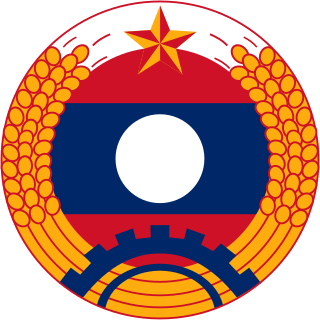
The Lao People's Armed Forces is the armed forces of the Lao People's Democratic Republic and the institution of the Lao People's Revolutionary Party, who are charged with protecting the country.
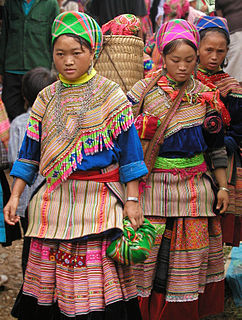
The Hmong/Mong people are indigenous people that mainly live in Southwest China, Vietnam, Laos, Thailand, and Myanmar. They have been members of the Unrepresented Nations and Peoples Organization (UNPO) since 2007. In China they are classified as a subgroup of the Miao people.
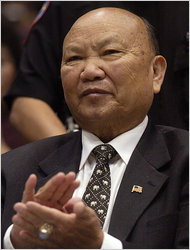
Vang Pao was a major general in the Royal Lao Army. He was a leader of the Hmong American community in the United States.
Wat Tham Krabok is a Buddhist temple (wat) in the Phra Phutthabat District of Saraburi Province, Thailand.

Hmong Americans are Americans of Hmong ancestry. Most Hmong Americans consist of those that fled to the United States as refugees in the late 1970s due to their cooperation with the United States' Central Intelligence Agency operatives in northern Laos during the Vietnam War, and their descendants. Over half of the Hmong population from Laos left the country, or attempted to leave, in 1975, at the culmination of the war. At the time, the Pathet Lao launched an aggressive campaign to capture or kill Hmong soldiers and families who aided the CIA. Thousands of Hmong were evacuated or escaped on their own to Hmong refugee camps in Thailand. About 90% of those who made it to refugee camps in Thailand were ultimately resettled in the United States. The rest, about 8 to 10%, resettled in countries including Canada, France, the Netherlands, and Australia. According to the 2019 American Community Survey by the US Census Bureau, the population count for Hmong Americans was 327,000.

The situation of human rights in Laos has often been, and remains, a recognized cause for serious concern. Laos is one of a handful of Marxist-Leninist governments and is ruled by a one-party communist government backed by the Lao People's Army in alliance with the Vietnam People's Army and the Socialist Republic of Vietnam in Hanoi.
The insurgency in Laos was waged primarily by members of the former "Secret Army", Laotian royalists, and rebels from the Hmong and lowland Lao ethnic minorities. These groups have faced reprisals from the Lao People's Army and Vietnam People's Army for their support of the U.S.-led, anti-communist military campaigns in Laos during the Laotian Civil War, which the insurgency is an extension of itself. The North Vietnamese invaded Laos in 1958 and supported the communist Pathet Lao. The Vietnamese communists continued to support the Pathet Lao after the end of the Laotian Civil War and the establishment of the Lao People's Democratic Republic.
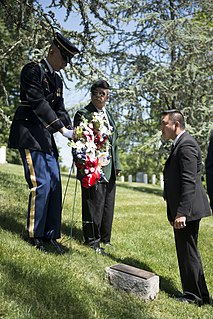
The Hmong and Lao Memorial, or Lao Veterans of America Monument, is a granite monument, bronze plaque and living memorial in Arlington National Cemetery in the US. Dedicated in May 1997, it is located in Section 2 on Grant Avenue between the path to the JFK memorial and the Tomb of the Unknowns, in Arlington National Cemetery, Arlington, Virginia, in the United States. The Laos–Hmong memorial commemorates the veterans of the "Secret War" in Laos who fought against invading Soviet Union-backed North Vietnam Army forces of the People's Army of Vietnam and communist Pathet Lao guerrillas. Approved by the U.S. Department of Defense, Arlington National Cemetery, and the U.S. Department of the Army, but designed and paid for privately by the Lao Veterans of America, Inc., the Lao Veterans of America Institute, and The Centre for Public Policy Analysis, the memorial stands as a tribute to the Hmong, Lao, other ethnic groups, and American clandestine and military advisers who made up the Secret War effort during the Vietnam War. The Lao Veterans of America, Inc. is the nation's largest ethnic Laotian- and Hmong-American veterans organization.
The alleged 2007 Laotian coup d'état plan was a conspiracy allegation by the United States Department of Justice that Lt. Col. Harrison Jack (Ret.) and former Royal Lao Army Major General Vang Pao, among others conspired in June 2007 to obtain large amounts of heavy weapons and ammunition to overthrow the Communist government of Laos in violation of the Neutrality Act. The charges were ultimately dropped and the case helped serve to further highlight, instead, major human rights violations by the Lao government against the Hmong ethnic minority, Laotian refugees, and political dissidents.

Relations between Laos and the United States officially began when the United States opened a legation in Laos in 1950, when Laos was a semi-autonomous state within French Indochina. These relations were maintained after Lao independence in October 1953.
Vang Pobzeb was a Hmong American dedicated to Lao and Hmong human rights. For over 25 years, he was an outspoken critic of the Marxist governments of the Pathet Lao in Laos and the Socialist Republic of Vietnam (SRV) and their human rights violations, religious freedom violations, and persecution of the Lao and Hmong people.
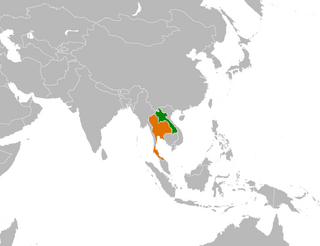
Laos and Thailand have had bilateral relations since the time of their precursor Lan Xang and Ayutthaya kingdoms in the 15th century. The two countries share a border and express linguistic and cultural similarities. The Lao kingdom of Lan Xang included all of northeastern Thailand as recently as the early 18th century. Thailand's northeastern region, Isan, has particularly strong Lao roots. Linguistically, the inhabitants of Isan, a third of the Thai population, speak the Isan language, a Lao dialect. Diplomacy has concentrated on the Mekong River, seeking to make it a "river of true peace and friendship", as made explicit in statements by both respective prime ministers in 1976.
The Center for Public Policy Analysis (CPPA), or Centre for Public Policy Analysis, was established in Washington, D.C. in 1988 and describes itself as a non-profit, non-partisan, think tank and research organization. The CPPA is a non-governmental organization (NGO) focused on foreign policy, national security, human rights, refugee and international humanitarian issues. Its current Executive Director is Philip Smith.
The Lao Veterans of America, Inc., describes itself as a non-profit, non-partisan, non-governmental, veterans organization that represents Lao- and Hmong-American veterans who served in the U.S. clandestine war in the Kingdom of Laos during the Vietnam War as well as their refugee families in the United States.
The United League for Democracy in Laos, Inc. (ULDL) is a non-profit, non-governmental organization (NGO) based in the Washington, D.C.-area with chapters and members in the United States, Thailand and Laos. The ULDL has works to provide information about developments in Laos regarding civil society, human rights, pro-democracy, religious freedom, political prisoners and environmental issues.
Cherzong Vang was an American community leader from St. Paul, Minnesota. He was an elder of the Hmong people in Laos and the Lao-American community in the Twin Cities of the United States.

Wangyee Vang is a Hmong-American community leader, educator and elder from Fresno, and the Central Valley, of California.
The Lao Veterans of America Institute (LVAI) is a national non-profit organization based in Fresno, and the Central Valley, of California, with chapters throughout California. It is one of the largest ethnic Lao- and Hmong-American veterans organizations representing tens of thousands of Lao Hmong veterans who served in the Vietnam War in the Royal Kingdom of Laos as well as their refugee families who were resettled in the United States after the conflict.
Ban Vinai Refugee Camp, officially the Ban Vinai Holding Center, was a refugee camp in Thailand from 1975 until 1992. Ban Vinai primarily housed highland people, especially Hmong, who fled communist rule in Laos. Ban Vinai had a maximum population of about 45,000 Hmong and other highland people. Many of the highland Lao were resettled in the United States and other countries. Many others lived in the camp for years which came to resemble a crowded and large Hmong village. The Royal Thai Government closed the camp in 1992, forced some of the inhabitants to return to Laos and removed the rest of them to other refugee camps.
References
- ↑ Chaipipat, Kulachada (June 14, 2000). "Lao govt accused of persecuting Hmong". The Nation (Thailand). Archived from the original on 2015-09-24. Retrieved 2020-12-22.
- ↑ Bonner, Brian (January 30, 1997). "Human rights in Laos still poor, U.S. says". Knight Ridder/Tribune News Service. Archived from the original on 2015-09-24. Retrieved 2020-12-22.
- ↑ "Home". 2014-12-21. Archived from the original on 2014-12-21. Retrieved 2020-12-22.
- ↑ "UNPO: Legislators appeal to Laos to aid Hmong". www.unpo.org. Retrieved 2020-12-22.
- ↑ Corben, Ron (August 31, 2006). "VOA News: Laos Denies Attacks on Hmong, as Activist Report Abuses in Laos, Thailand". US Fed News Service. Archived from the original on 2016-03-09.
- ↑ China Weekly News, (16 February 2010) "Laos, Thailand Hmong Refugee Crisis: US Congress Urges UN Access, Resettlement Abroad."
- ↑ "Laos: Attacks Intensify Against Lao, Hmong People". www.businesswire.com. 2013-03-04. Retrieved 2020-12-22.
- ↑ "Laos: Attacks Intensify against Lao, Hmong People". Politics & Government Week. March 21, 2013. Archived from the original on 2015-09-24. Retrieved 2021-09-28.
- ↑ "Laos: Coalition Opposes U.S. Taxpayers' Funding of Bomb Removal From Vietnam War". businesswire. 2013-04-12. Retrieved 2021-09-20.
{{cite web}}: CS1 maint: url-status (link) - ↑ Politics and Government Week, (2 May 2013) "Laos: Coalition Opposes U.S. Taxpayers' Funding of Bomb Removal from Vietnam War"
- ↑ "AptaIT offers bioinformatic services and user-friendly software for next-generation sequencing analysis". aptait (in German). Retrieved 2021-09-20.
- ↑ Weiner, Tim (2008-05-11). "Gen. Vang Pao's Last War". The New York Times. ISSN 0362-4331 . Retrieved 2021-09-20.
- ↑ "Laos: Opposition to US Funding of Bomb Clearing From Vietnam | Scoop News". Scoop World. Retrieved 2021-09-20.
{{cite web}}: CS1 maint: url-status (link) - ↑ China Weekly News, (13 January 2009) "Hmong Crisis: Thailand's PM Abhisit, Gen. Anupong Mobilize Army to Force Hmong Refugees to Laos."
- ↑ "Senate Questions U.S.–Thailand Military Funding as Anupong, Abhisit Move To Force Hmong to Laos". Asia Business Newsweekly. January 12, 2010. Archived from the original on 2015-03-29. Retrieved 2021-09-28.